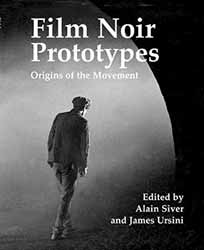|
Click here to return to the main site. Book Review
Decades ago, film students are questioning Edward Dmytryk about ‘film noir’. In this class are students who would go on to dominate Hollywood film to this day. They notice the director often excuses himself and steps off the dais for privacy then returns, enthused, invigorated. One of the students asks him to tell them ‘about film noir.’ Dmytryk: ‘What’s film noir?’ And they tell him: ‘You were one of the founders of film noir.’ Dmytryk: ‘Really?’ And as the director elaborated in a later interview: ‘I didn’t know what the hell it was.’ (Hollywood The Golden Years: The RKO Story – Episode 5: Dark Victory). Dmytryk explains film noir came naturally to him, settings were more down to earth, gritty with a feeling for concrete reality, streets and alleys of urban life and ambiguity but more than setting, a psychological tone. Reality inescapable, in the outer world as well as the inner mind. A category of surface and shadow as well as an inner inexorable truth. Alain Silver and James Ursini have written and edited a new volume Film Noir Prototypes: Origins of the Movement. (Applause Theatre and Cinema Books) that builds on last year’s [2017] artful and foundational Film Noir Light and Shadow (also Applause). The latter focuses on films of the nineteen forties, war time and post war but with an awareness that the typology, ‘whether one dubs it a movement, a style, a cycle, a period, or (horrors!) a genre’. A movie does not ‘absolutely’ have to include Silver’s Nine Elements of Film Noir Style ‘to qualify a film as noir.’ This from film essayist Allison Rodriquez who reminds that all the ‘elements are simply common characteristics of any film that is noir.’ Of course we’re dealing with light and its converse, darkness. In the ambiguity of their commingling we delve into shadow. As stated above, this is photonic and also psychological, the lightness or darkness of our minds. Silver and Ursini guide the new fan as well as the veteran viewer in the elemental application in Light and Shadow, but in Film Noir Prototypes, Origins of the Movement they time-travel back to the 1930s and further into silent classics. Paleo-noir and Proto-noir are essential to this subject because they offer a heretofore undelivered context and aesthetic precedence and as the title promises, origins. Before going further we must gasp with hushed appreciation for the image printing in both books. It’s no easy task to get imagery from older films. This study in light and shadow demands a hallowed approach to the art and Silver delivers a photographic feast. The art of black and white photography is alive and well and for these mesmerizing digital captures, we must thank him alone. The dense but always thoughtful text by all contributors make these books a serious appreciation of art for its own sake. German expressionism of the teens and twenties (f.i. Kirchner, Munch) is seen to influence films (Jessner, Murnau. Pabst) but an essay by Robert Porfirio time-travels forward into the forties and fifties for a dazzling continuity through continents and time. Look for Proto-noir influences in Fritz Lang’s Metropolis and the early epics of DeMille. Implicit in all this is that these films should not be lost to us today, they are feasts for the eye. And then there’s Hitchcock. Much debate here on whether he is noir, marginal noir or secret noir. Richard Edwards’ fine exploration of Hitchcock Before Noir. settles I think, any questions about this robust artist’s noir credentials. In 1925 he was loaned to a studio in Germany and was exposed to the work of Murnau and Lang at UFA. Some of his films were satisfying, some not, but out of this period comes his triumphant return to Britain and The Lodger (1927). To describe it as ‘pre-noir’ or ‘prototype noir’, is, I think, a mistake. All the elements of noir are here in confident consummation. James Ursini’s Crime and Punishment – The Mother of All Noir is the mother of all noir studies. He takes filmic adaptations of the Dostoevsky novel from the 1923 Raskolnikow (Robert Wiene) to Crime and Punishment (Josef von Sternberg, 1935) Crime et Châtiment (Pierre Chenal, 1935), Crime and Punishment (Denis and Terry Sanders, 1959 collaborating with cinematographer Floyd Crosby who worked with Murnau, Pare Lorentz and Roger Corman), Crime + Punishment in Suburbia (Rob Schmidt, 2000). Ursini cuts the diamond as the intellectual jeweller he is. Same story. Well, almost. Six decades of treatment, all reflecting facets of noir. This is nothing short of a doctoral thesis on the subject, it’s variances and its consistencies, and worth the purchase of Film Noir Prototypes alone. I’m used to hearing people groan when I bring up black and white films. ‘Yuck and white,’ a kid once said. ‘I don’t do black and white,’ said another. When a fan of Johnny Depp and Tim Burton films revealed she had seen them all, I asked if she’d liked Ed Wood. Oh no, she frowned, I would never see that one, it’s in black and white. ‘But that’s the best of the lot,’ I told her. That made her frown again. I gave her no quarter. That really made her go prune-face. I talked with an aficionado of Polish outré music videos. ‘You notice they sometimes verge into black and white, emphatically noir?’ Ten stars, ten noir stars. 10 John Huff Buy this item online
|
|---|


